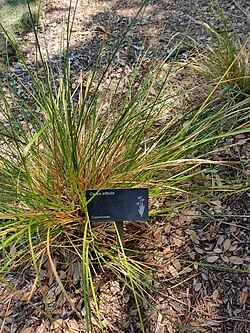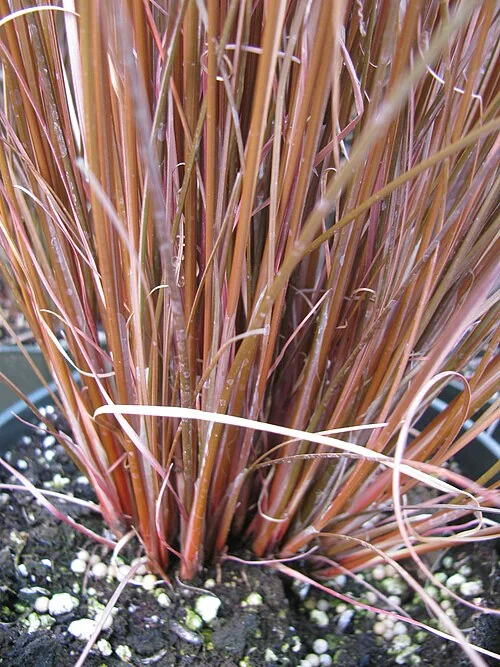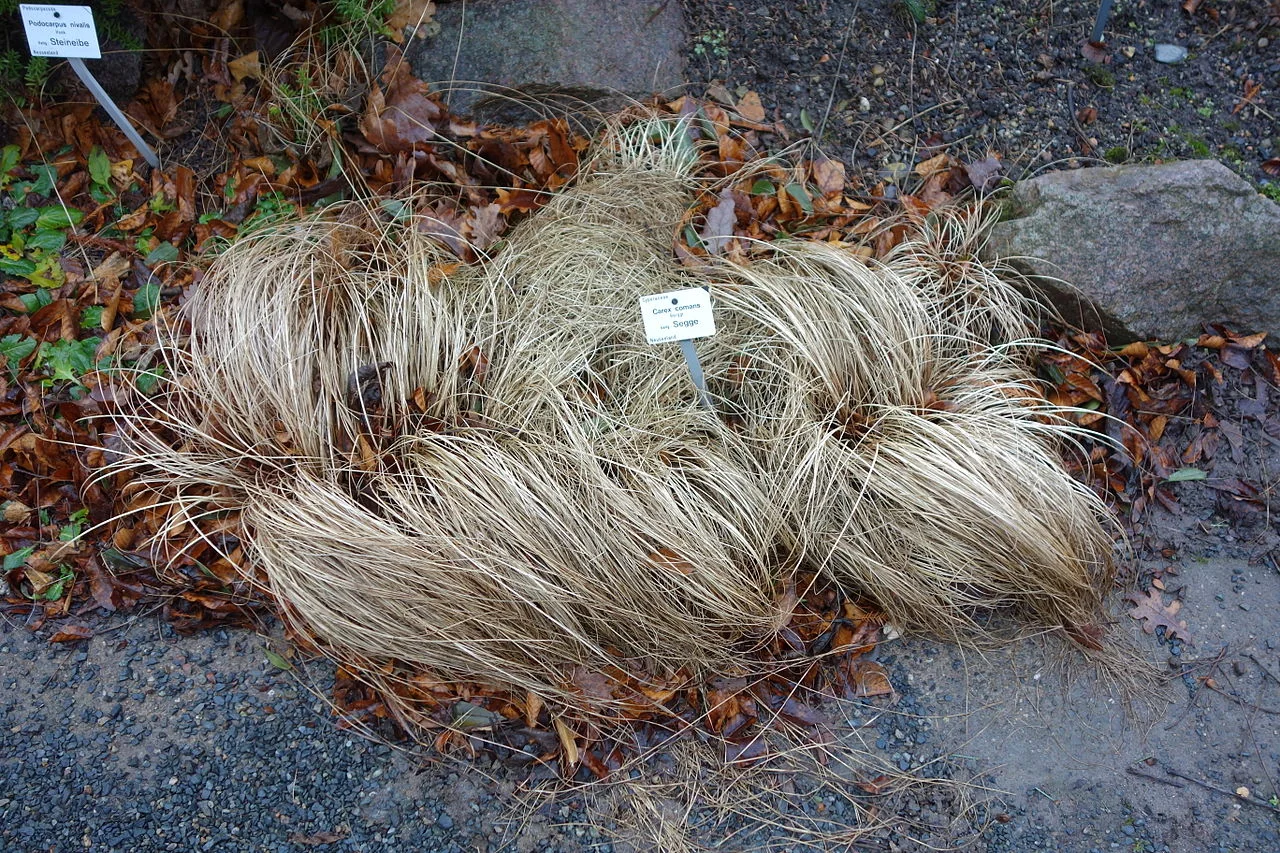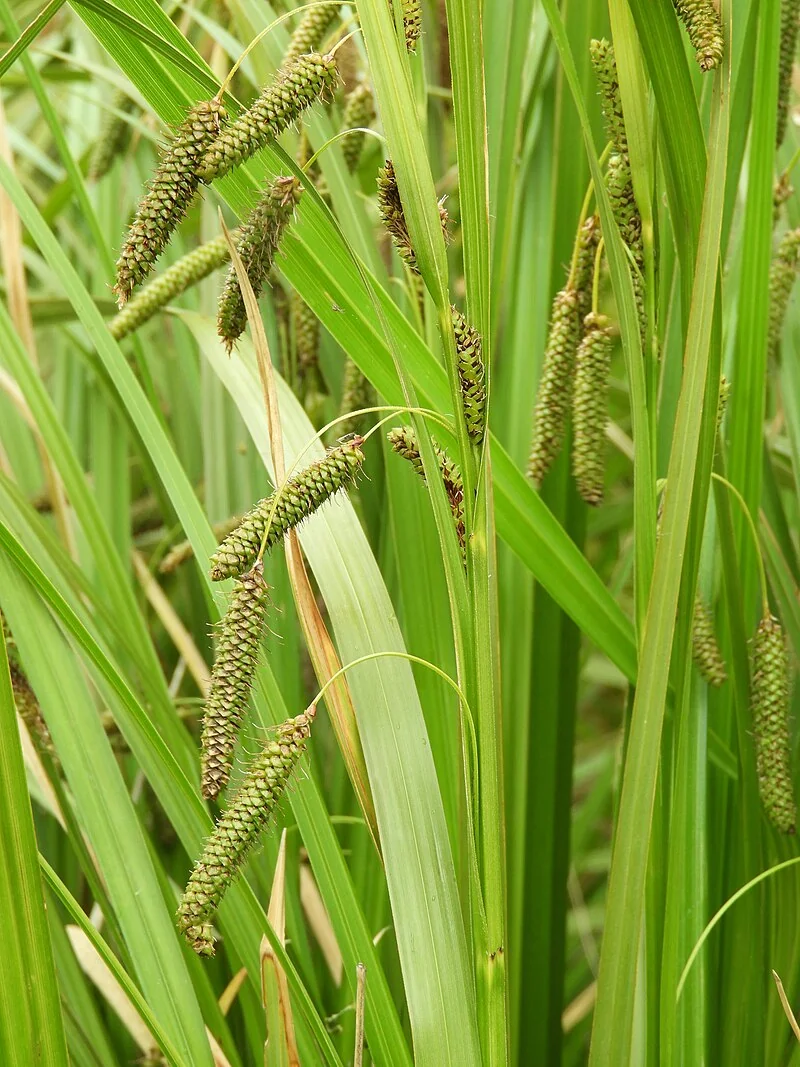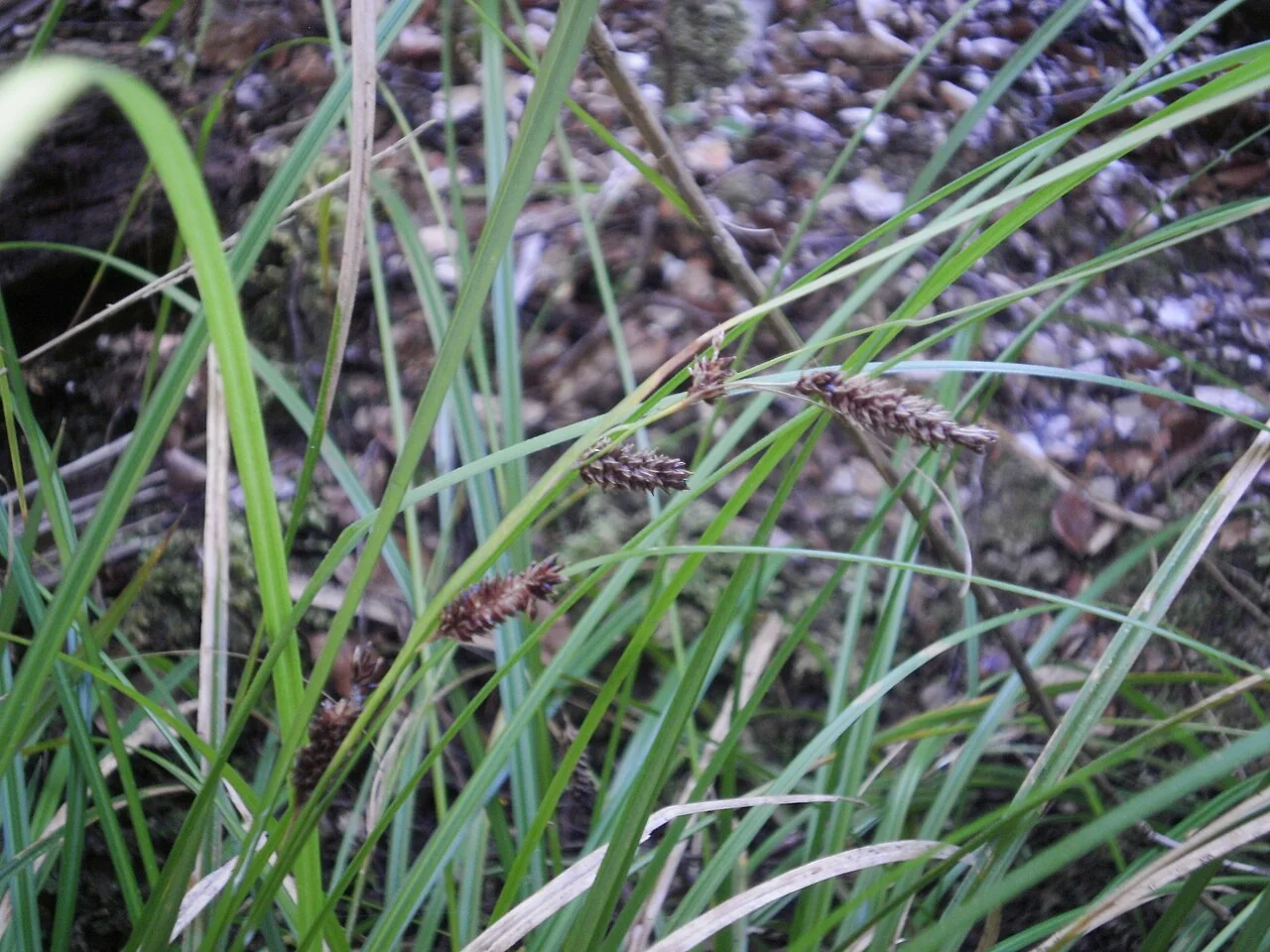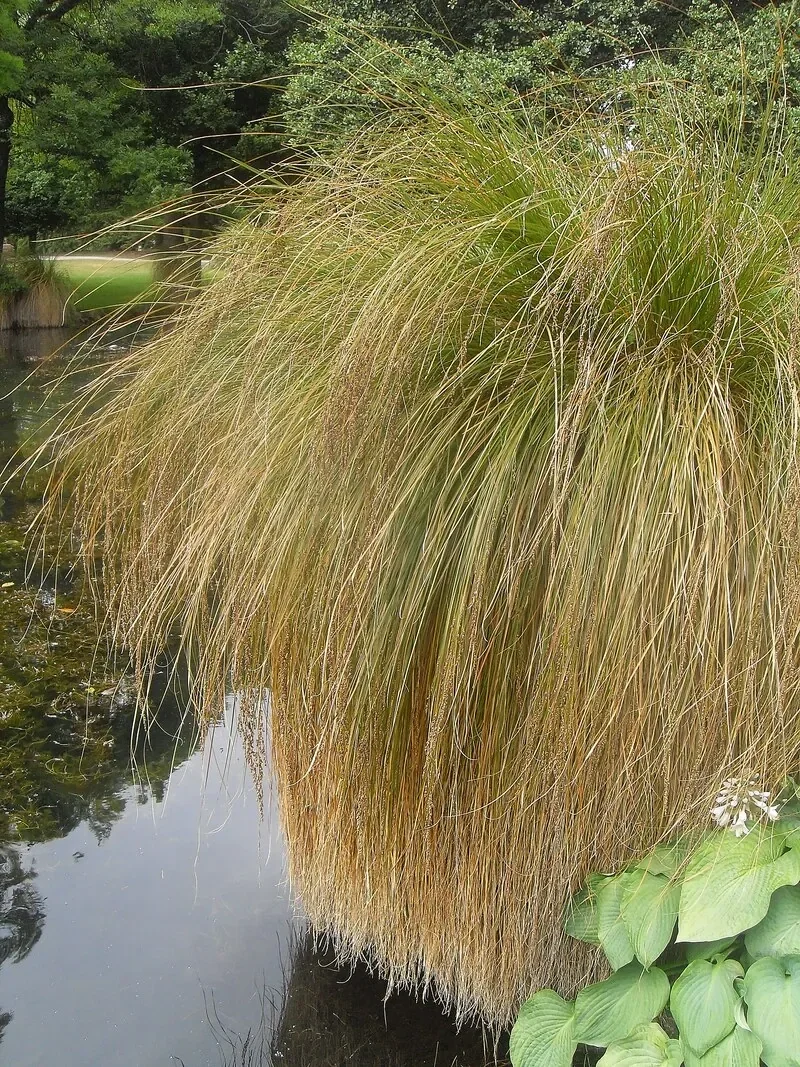
Orange Sedge
Carex testacea
Explore more NZ native plant guides in our index .
Introduction
About Orange Sedge
Carex testacea , commonly known as Orange Sedge or New Zealand Hair Sedge, is a graceful native sedge endemic to New Zealand's North, South, and Stewart Islands, renowned for its spectacular seasonal colour transformations and distinctive architectural form. This densely tufted perennial forms graceful clumps 0.3-0.6 m high with trailing culms extending up to 2 m long, creating cascading displays of fine, hair-like foliage that transitions from olive-green in winter to brilliant copper-orange in summer sun exposure. Botanically characterized by its narrow leaves (0.5-1.5mm wide) with distinctive orange-red coloration, this species produces drooping light green to yellow-green flower spikes from October to December, making it highly valued for its year-round ornamental interest. Popular cultivars like 'Prairie Fire' have been selected for intensified orange-bronze colouring, while the species' exceptional drought tolerance once established, combined with its adaptability from coastal to montane environments (sea level to 1200 m), makes it a premier choice for contemporary landscape design, rock gardens, alpine collections, and specialized horticultural applications.

Plant Description
Carex testacea , commonly known as Orange Sedge or New Zealand Hair Sedge, is a graceful evergreen perennial sedge endemic to New Zealand. It forms dense, arching mounds of fine, hair-like foliage that can reach about 60cm in height. This sedge is particularly prized for its spectacular seasonal colour transformations: its leaves are typically olive-green in partial shade but develop vibrant copper-orange to bronze hues in full sun, especially during summer and winter. Its inconspicuous flowers appear in late summer. Drought-tolerant and low-maintenance, it is a popular ornamental grass for gardens and containers.
Quick Facts
| Scientific Name | Carex Testacea |
|---|---|
| Height | 15-20 m |
| Spread | 3-5 m |
| Water Needs | Moderate |
| Light | Full sun to part shade |
| Frost Tolerance | Moderate |
| Salt Tolerance | Moderate |
| Growth Rate | Medium |
| Lifespan | Long |
Climate Best Suited to
White maire (Nestegis lanceolata) is primarily found in lowland to hilly forests across the North Island of New Zealand, extending to the Marlborough Sounds in the South Island. It demonstrates good adaptability to various conditions, thriving in areas with well-drained soils and tolerating both full sun and partial shade. Its natural distribution suggests a preference for warmer, more humid environments but with a reasonable tolerance for cooler temperatures found in its southern range.
Regional Suitability
| Whangārei | Ideal |
| Auckland | Ideal |
| Hamilton | Suitable |
| Rotorua | Suitable |
| Tauranga | Ideal |
| Gisborne | Ideal |
| New Plymouth | Ideal |
| Whanganui | Ideal |
| Palmerston North | Suitable |
| Napier | Ideal |
| Wellington | Ideal |
| Nelson | Ideal |
| Christchurch | Suitable |
| Dunedin | Suitable |
| Invercargill | Suitable |
| City | Climate Suitability |
|---|
Habitat
Natural Distribution
Carex testacea , commonly known as Orange Sedge or New Zealand Hair Sedge, is a graceful native sedge endemic to New Zealand, found throughout the North, South, and Stewart Islands. It is highly adaptable and thrives in a variety of habitats, ranging from coastal to montane regions, up to 1200 meters above sea level.
Specifically, its natural habitats include free-draining soils under scrub, tall forest, or in relatively open vegetation. It is commonly found in sand dunes, coastal forest and scrub, dense forest, short tussock ( Festuca novae-zelandiae ) grassland, and open woodlands. This sedge is tolerant of a wide range of conditions, except for permanently waterlogged soils. It thrives in well-draining soils and can tolerate partial to full sun, with brighter light often intensifying its characteristic orange-bronze coloration. Once established, it is remarkably drought-tolerant, making it a resilient component of New Zealand's diverse landscapes.
Plant Conservation
Carex testacea is classified as "Regionally Not Threatened" in the Auckland region according to the New Zealand Threat Classification System assessments conducted in 2022-2023. This endemic New Zealand sedge maintains stable populations across North, South, and Stewart Islands, demonstrating good conservation security in its native range.
The species benefits from its wide distribution and exceptional adaptability to diverse habitats from coastal to montane regions up to 1200 meters elevation. Its tolerance for various soil conditions (except permanently waterlogged soils) and drought resilience once established contribute to its conservation stability and ecological resilience.
An important conservation consideration involves the species' potential invasive behavior outside its native range. In regions like Australia, Orange New Zealand Sedge has the potential to become a serious weed in gardens, pastures, and native habitats, spreading through both seed dispersal and rhizomatous growth. This highlights the importance of responsible cultivation practices in non-native environments.
Conservation efforts benefit from the species' popularity in international horticulture, which raises awareness of New Zealand's native flora while reducing collection pressure on wild populations. Its widespread cultivation provides opportunities for ex-situ genetic conservation, though care must be taken to prevent escapement and establishment in non-native ecosystems where it could become invasive.
Growing Requirements
Soil Requirements
White maire (Nestegis lanceolata) is remarkably adaptable to different soil conditions, thriving in well-drained environments. It can tolerate a variety of soil types, from sandy to loamy, and prefers a neutral to slightly acidic pH. Good drainage is crucial to prevent root rot, ensuring healthy growth and development.
- Tolerates a wide range of soil types from clay to sandy
- Prefers well-draining soils but can handle occasional waterlogging
- Thrives in moderately fertile soils but will grow in poor soils too
- Can tolerate slightly acidic to slightly alkaline pH
- Handles coastal conditions including salt spray
Light Requirements
White maire (Nestegis lanceolata) thrives in a variety of light conditions, from full sun to partial shade. Optimal growth and flowering are typically achieved in locations receiving ample sunlight throughout the day. However, it can also tolerate some shade, especially in hotter climates, where it benefits from protection during the most intense afternoon sun.
- Full sun for optimal growth and form
- Can tolerate partial shade but may develop a leggier form
- At least 6 hours of direct sunlight daily is ideal
- Northern or eastern exposures work well in garden settings
Water Requirements
Once established, White maire (Nestegis lanceolata) is remarkably drought-tolerant, requiring minimal supplemental watering. During its establishment phase, consistent moisture is crucial to encourage strong root development. Mature plants can withstand dry periods, but regular watering during prolonged droughts will promote healthier growth and more abundant flowering.
- Moderate watering during establishment (first 1-2 years)
- Drought-tolerant once established
- Can handle periods of soil saturation
- Reduce watering in winter when growth slows
- Signs of overwatering include yellowing leaves and crown rot
Planting Guide
-
When to Plant
Plant in autumn or spring.
-
Site Preparation
Choose a sunny or partially shaded site with moist, well-drained soil.
-
Planting and Aftercare
Dig a hole twice the width of the pot. Place the plant in the hole and backfill with soil. Water well and apply a layer of mulch.
Ecological Significance
Carex testacea , commonly known as Orange Sedge or Copper Sedge, is a species of flowering plant native to New Zealand. This densely tufted, evergreen perennial sedge plays several important ecological roles within its native ecosystems.
- Habitat Adaptability: Carex testacea is highly adaptable, thriving in a wide range of habitats from coastal sand dunes, coastal forest and scrub, to dense forest and short tussock grassland, and even montane regions. This broad habitat tolerance allows it to contribute to the ecological structure of diverse environments.
- Erosion Control and Soil Stabilization: The plant is valuable for erosion control and stabilizing soil, particularly in coastal and dry environments, as well as on banks and slopes. Its fibrous root systems enhance soil health by creating channels for air and water, and by releasing nutrients and organic matter as they decompose.
- Provision of Shelter: It provides shelter and cover for small native insects, contributing to local invertebrate biodiversity and supporting the food web.
- Drought and Salt Tolerance: Carex testacea is drought-tolerant once established and exhibits good salt tolerance, making it a resilient species in challenging coastal conditions where many other plants struggle.
- Pioneer Species: It is recognized as a pioneer species, indicating its role in colonizing disturbed or newly formed areas and contributing to early ecological succession, helping to establish vegetation in harsh environments.
- Biodiversity Contribution: As a native species, Carex testacea is an integral component of New Zealand's natural flora, contributing to the overall biodiversity of these ecosystems and supporting the unique plant communities found there.
Uses and Significance
Garden Uses
- Specimen tree for visual impact
- Suitable for native gardens and restoration projects
- Enhances native garden aesthetics and biodiversity
- Provides architectural accent with its unique structure
- Effective for erosion control on slopes and banks
Ecological Value
Ecologically, White maire (Nestegis lanceolata) plays a crucial role in supporting native ecosystems. Its fruits are a food source for birds, especially the kererū, contributing to the local biodiversity and food web.
- Provides a vital food source for native birds, especially the kererū
- Offers habitat and nesting sites for various fauna
- Contributes to soil stabilization and nutrient cycling
- Forms natural shelter belts, protecting other species
Cultural Significance
Traditional Uses and Values
While not as widely documented for traditional Māori uses as some other native plants, Orange Sedge ( Carex testacea ) was part of the unique high-country landscape and would have been known to local iwi. Its distinctive appearance would have made it a recognizable feature of the dry interior regions of the South Island.
Landscaping Uses
Garden Design Applications
Carex testacea , also known as Orange Sedge or New Zealand Hair Sedge, is a popular ornamental grass-like plant valued for its distinctive coppery-orange foliage and graceful, arching habit. It offers year-round visual interest and is highly versatile for various landscaping applications due to its adaptability and low maintenance requirements.
- Mass Plantings and Groundcover: It is excellent for creating large drifts of colour and texture, suppressing weeds, and providing erosion control on banks and slopes. Its dense growth habit makes it an effective groundcover in suitable areas.
- Borders and Edging: Its neat, clump-forming habit makes it suitable for defining pathways, garden beds, and borders, adding a soft, inviting edge and visual interest.
- Containers and Patios: Carex testacea thrives in pots, making it an ideal choice for container gardens, balconies, or as a focal point, where its arching foliage can spill gracefully over the sides.
- Accent and Feature Plant: It serves as a striking accent, providing warm colour and soft texture in various garden settings, including rock gardens and modern landscapes. Its coppery tones blend beautifully with darker foliage and contrast with purple or blue flowering plants.
- Coastal and Windy Sites: This sedge is tolerant of salt-laden winds and coastal exposure, making it a robust choice for seaside gardens where many other plants struggle.
- Under Trees: It can be used in large areas under trees to add texture and contrast, provided the soil is free-draining and it receives adequate light to maintain its colour.
- Mixed Plantings: Carex testacea pairs well with other ornamental grasses, perennials, and shrubs, creating dynamic and visually appealing combinations.
- Near Ponds or Streams: Its foliage can be reflected in water features, adding to the aesthetic appeal and creating a serene atmosphere.
Beyond its aesthetic appeal, Carex testacea is appreciated for being low-maintenance, drought-tolerant once established, and resistant to deer and rabbits. It prefers well-drained soil, and its vibrant orange coloration is most pronounced when grown in full sun, though it tolerates partial shade.
Seasonal Care Calendar
Spring
In spring, White maire (Nestegis lanceolata) begins its active growth phase. New foliage emerges, and it's an ideal time for planting new specimens or propagating. Ensure adequate moisture and monitor for early signs of pests.
- New growth begins with fresh foliage development
- Apply a balanced, slow-release fertilizer if desired
- Excellent time for planting new specimens or dividing offsets
- Monitor for new pest activity and address promptly
Summer
Summer is the peak growing season for White maire (Nestegis lanceolata), often accompanied by flowering. Consistent watering is important, especially for young plants, to support vigorous growth and prevent stress during dry periods.
- Flowering typically occurs in early to mid-summer (November-January)
- Water young trees regularly during extended dry periods
- Avoid heavy pruning during the active growing season
Autumn
During autumn, White maire (Nestegis lanceolata) prepares for the cooler months. Fruits or berries develop, providing food for native birds. It's also a good time for planting and general garden cleanup.
- Fruits or berries develop and ripen (December-February), attracting birds
- Natural leaf shedding occurs as part of its growth cycle
- Good time for planting new specimens to establish before winter
- Clean up fallen leaves if a tidy appearance is desired
Winter
Winter is generally a dormant period for White maire (Nestegis lanceolata). Minimal care is required, though young plants may benefit from protection in colder regions. This is an opportune time for any necessary structural pruning.
- Generally dormant with minimal growth activity
- No special winter protection needed in most mild climates
- Suitable time for structural pruning if required
- Fallen leaves can be left as mulch or removed for tidiness
When to Prune and How Much
White maire (Nestegis lanceolata) generally requires minimal pruning to maintain its natural form and health. Pruning should focus on removing dead or damaged growth and shaping the plant as needed.
- Remove dead, damaged, or diseased branches at any time of year
- Light formative pruning when young helps establish good structure
- To create a multi-trunked specimen, cut the main stem to encourage branching
- Fallen leaves can be removed for a tidier appearance, or left as natural mulch
- If necessary, lower branches can be removed to create clearance underneath
- Major pruning is best done in late winter to early spring before new growth
Always use clean, sharp tools for pruning to minimize the risk of disease and ensure clean cuts. The plant often responds well to pruning with vigorous new growth, contributing to a fuller, healthier appearance.
How to Grow Orange Sedge
From Division
Division represents the most reliable and efficient propagation method for Orange Sedge, taking advantage of this spectacular ornamental grass's natural clumping habit while preserving the distinctive seasonal colour characteristics that make selected cultivars so valuable in contemporary landscape design. This graceful native sedge forms densely tufted clumps through fibrous root systems, making it exceptionally straightforward to divide while maintaining the genetic characteristics responsible for the brilliant copper-orange summer coloration and olive-green winter tones. The optimal timing for division is during spring or early autumn when the plant is either emerging from dormancy or preparing for winter rest, providing divided sections with favorable establishment conditions before facing environmental stress. Spring division is particularly advantageous as it allows new plants to establish throughout the growing season while developing the robust root systems necessary for the spectacular colour development that occurs during summer months. Begin by carefully lifting established clumps that are at least 2-3 years old and showing vigorous growth, using a garden fork to work gently around the perimeter while preserving the shallow but extensive fibrous root system. Orange Sedge develops a relatively compact root mass compared to larger sedges, making it easier to handle during division while requiring careful attention to preserve root integrity for optimal establishment and colour development. Once lifted, examine the clump structure to identify natural division points where separate growing centers have developed, typically visible as distinct tufts of the characteristic fine, hair-like foliage emerging from different areas within the colony. The clumping growth habit creates clear separation opportunities that can be exploited with minimal root damage, ensuring each division maintains the genetic potential for the distinctive seasonal colour transformations. Use clean hands or small tools to separate divisions along natural boundaries, ensuring each section includes both healthy roots and sufficient crown material to support the plant's characteristic trailing culms and seasonal colour development. Divisions can be relatively small as this species establishes readily, with sections containing 3-4 growing points capable of developing into full-sized ornamental clumps within one growing season while expressing the full range of seasonal colour variation. Each division should include adequate root mass and multiple growing shoots to support establishment and the energy requirements for producing the extended trailing culms that can reach up to 2 meters in length. Replant divisions immediately at the same depth they were previously growing, spacing them 40-60cm apart to accommodate their mature spread and cascading growth habit while allowing each plant to develop its full ornamental potential. Choose locations with full sun to partial shade and well-draining soil, as this adaptable species thrives in diverse conditions but performs best with good drainage and adequate sunlight to develop the intense orange-bronze coloration that makes it so valuable ornamentally. Water thoroughly after planting to settle soil around roots, then maintain moderate moisture during establishment while allowing plants to develop the drought tolerance that makes them so valuable for low-maintenance landscape applications.
From Seeds
Seed propagation provides an economical method for growing Orange Sedge that allows for natural selection of plants with superior colour characteristics while maintaining the genetic diversity that supports adaptation to various growing conditions. This attractive native sedge produces viable seeds through drooping light green to yellow-green flower spikes that develop from October to December, providing opportunities for collection during the extended fruiting season when seeds reach maturity. The natural variation within seed-grown populations offers exciting possibilities for selecting plants with particularly intense seasonal coloration, compact growth habits, or other desirable characteristics that enhance ornamental value in landscape applications. Collect fresh seeds from the drooping flower spikes during late autumn to early winter when seeds have fully matured and are beginning to disperse naturally, cutting entire seed heads with clean secateurs and placing them in paper bags to complete drying in well-ventilated conditions. Seeds maintain good viability when collected fresh and should be sown immediately in autumn for optimal germination results, as this species benefits from the natural cold stratification that occurs during winter months. The variable colour expression in seed-grown populations means that some seedlings may show enhanced orange-bronze coloration while others express more subdued tones, providing opportunities for selection and potentially developing new ornamental forms. Prepare well-draining seed-raising mix using standard compost with added perlite or coarse sand to ensure adequate drainage while maintaining the consistent moisture levels necessary for germination without creating waterlogged conditions. Sow seeds thinly on the surface of firm, moist growing medium, covering lightly with a thin layer of fine sand or vermiculite as they benefit from some light during germination while requiring protection from drying out. Place seed trays in a protected location with bright, indirect light and consistent cool temperatures throughout winter, allowing natural temperature fluctuations to provide the stratification necessary for breaking dormancy mechanisms. Maintain consistent moisture without waterlogging throughout the germination period, which typically occurs during spring as temperatures begin to warm and daylight hours increase, triggering the natural growth response. Young seedlings develop relatively quickly once germination occurs, establishing the characteristic tufted growth habit and beginning to show the fine, hair-like foliage texture that becomes more pronounced as plants mature and develop their distinctive seasonal colour patterns. Seedlings can be transplanted when they have developed sufficient root systems and foliage mass to handle garden conditions, typically after 8-10 weeks of growth under favorable conditions, though full colour development may take a complete growing season. This method is particularly valuable for creating diverse plantings where slight variation in colour intensity and growth characteristics adds visual interest and naturalistic appeal to landscape installations, while potentially identifying superior forms worthy of preservation through division.
From Cultivar Selection
Cultivar selection and breeding provides advanced propagation opportunities for Orange Sedge that focus on developing and maintaining superior ornamental forms with enhanced seasonal coloration, compact growth habits, or other desirable characteristics that increase landscape value. This approach is particularly important for preserving and distributing exceptional colour forms like 'Prairie Fire' and other selected cultivars that demonstrate intensified orange-bronze coloration superior to typical wild forms. The natural variation within Orange Sedge populations provides excellent raw material for selection work, with individual plants showing significant differences in colour intensity, seasonal timing of colour development, foliage texture, and overall ornamental appeal that can be identified and preserved through careful propagation techniques. Begin selection programs by establishing diverse populations from multiple parent plants or seed sources, allowing natural variation to express itself over several growing seasons while observing plants through complete annual cycles to assess their full ornamental potential. Evaluate plants for desirable characteristics including particularly intense orange-bronze summer coloration, attractive olive-green winter tones, compact or gracefully cascading growth habits, fine foliage texture, and reliable seasonal colour transitions that provide consistent ornamental value throughout the year. Document superior performers through detailed photographs taken at different seasons, precise measurements of colour development timing, and comprehensive notes about growing requirements and performance characteristics under various conditions. Propagate selected superior forms exclusively through division to maintain their exact characteristics, avoiding seed propagation which would introduce genetic variation and potentially dilute the specific traits being preserved and enhanced. Establish stock plants of selected forms in optimal growing conditions that promote the fullest expression of their desirable characteristics, including appropriate sun exposure for maximum colour development and well-draining soil conditions that support vigorous growth. Test selected forms under various growing conditions including different light levels, soil types, and moisture regimes to evaluate their adaptability and performance reliability across diverse landscape applications where they might be used. Develop comprehensive record-keeping systems that document the provenance, characteristics, and performance of selected forms to maintain their identity and ensure that valuable genetic material is not lost or confused with inferior selections. This advanced approach requires longer time commitments and more intensive management compared to simple propagation methods, but can produce exceptional ornamental forms that significantly enhance the landscape value and commercial potential of this already attractive native species. Collaborate with other growers and botanical institutions to preserve and distribute superior selections while contributing to the broader understanding and appreciation of New Zealand's native plant diversity in ornamental applications.
Pests and Diseases
Hardy Nature
Generally pest and disease free.
Watch for scale and fungal leaf spots; improve airflow and avoid over-watering to limit disease pressure.
Bonus Tip
Expert Growing Advice
The vibrant orange colour of Carex testacea is most intense when the plant is grown in full sun and in poorer soils. In richer soils or more shaded conditions, the foliage tends to remain more olive-green. So, for the best colour, don't be too kind to it!
